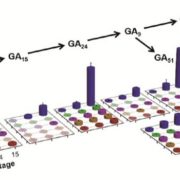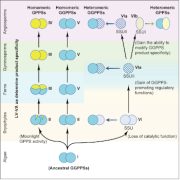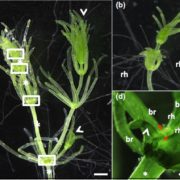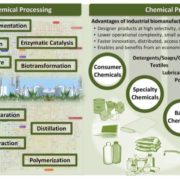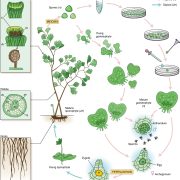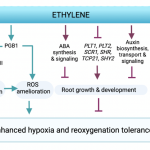Convergent evolution of red nectar in vertebrate-pollinated flowers (PNAS)
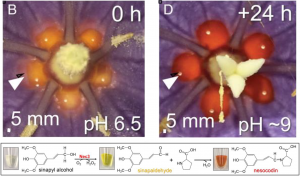 Nesocodon mauritianus is about one out of 70 plant species that produce colored nectar. The nectar of Nesocodon starts off yellow in newly opened flowers and progresses to blood-red in color as the flowers mature. The authors showed that the red colored nectar is both visible and attractive to geckos, the presumed pollinator of this and other Mauritian species. The authors identified sinapaldehyde in the nectar, which when conjugated to proline under alkalizing conditions results a red pigment named nesocodin. Nesocodin is synthesized from sinapyl alcohol to sinapaldehyde by an enzyme belonging to the glucose-methanol-choline oxidoreductase protein superfamily. A carbonic anhydrase increases the pH of the nectar to more alkaline conditions, allowing for the nonenzymatic conjugation of proline to sinapaldehyde to give nesocodin. Hydrogen peroxide is a by-product of sinapaldehyde formation that can break down the pigment; however, it is removed by a third enzyme, a catalase. The distantly related Jaltomata herrerae has red nectar and is pollinated by hummingbirds. The authors found nesocodin in the nectar of J. herrerae, as well as a carbonic anhydrase and an oxidoreductase for nesocodin biosynthesis. These findings inidicate that production of pigmented nectar in these two distantly-related vertebrate-pollinated flowers is a case of convergent evolution. (Summary by Kristen Van Gelder) PNAS 10.1073/pnas.2114420119
Nesocodon mauritianus is about one out of 70 plant species that produce colored nectar. The nectar of Nesocodon starts off yellow in newly opened flowers and progresses to blood-red in color as the flowers mature. The authors showed that the red colored nectar is both visible and attractive to geckos, the presumed pollinator of this and other Mauritian species. The authors identified sinapaldehyde in the nectar, which when conjugated to proline under alkalizing conditions results a red pigment named nesocodin. Nesocodin is synthesized from sinapyl alcohol to sinapaldehyde by an enzyme belonging to the glucose-methanol-choline oxidoreductase protein superfamily. A carbonic anhydrase increases the pH of the nectar to more alkaline conditions, allowing for the nonenzymatic conjugation of proline to sinapaldehyde to give nesocodin. Hydrogen peroxide is a by-product of sinapaldehyde formation that can break down the pigment; however, it is removed by a third enzyme, a catalase. The distantly related Jaltomata herrerae has red nectar and is pollinated by hummingbirds. The authors found nesocodin in the nectar of J. herrerae, as well as a carbonic anhydrase and an oxidoreductase for nesocodin biosynthesis. These findings inidicate that production of pigmented nectar in these two distantly-related vertebrate-pollinated flowers is a case of convergent evolution. (Summary by Kristen Van Gelder) PNAS 10.1073/pnas.2114420119


